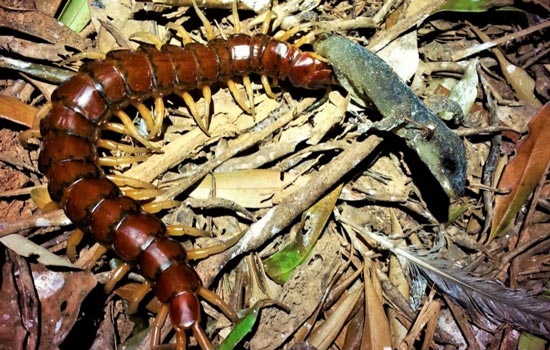Giant flesh-eating centipedes spotted preying on seabirds for first time, say scientists
Centipedes on Philip Island grow up to a foot in length and prey on 3700 seabird chicks each year

Your support helps us to tell the story
From reproductive rights to climate change to Big Tech, The Independent is on the ground when the story is developing. Whether it's investigating the financials of Elon Musk's pro-Trump PAC or producing our latest documentary, 'The A Word', which shines a light on the American women fighting for reproductive rights, we know how important it is to parse out the facts from the messaging.
At such a critical moment in US history, we need reporters on the ground. Your donation allows us to keep sending journalists to speak to both sides of the story.
The Independent is trusted by Americans across the entire political spectrum. And unlike many other quality news outlets, we choose not to lock Americans out of our reporting and analysis with paywalls. We believe quality journalism should be available to everyone, paid for by those who can afford it.
Your support makes all the difference.Scientists have reported the first known instance of giant flesh-eating centipedes hunting down and preying upon seabirds in Australia’s Philip Island.
According to the study, published in the journal The American Naturalist, the centipedes are the island’s apex predators, killing and eating a wide range of creatures, including geckos, crickets, scavenged fish, and thousands of chicks each year – playing an important role in the ecosystem.
The researchers, including those from Monash University in Australia, say the centipede, which grows up to a foot in length (30.5 centimetres), is armed with a potent venom encased in its two pincer-like appendages that it uses to immobilise its prey.
“Phillip Island centipede diet is represented by vertebrate animals (48%) and invertebrates (52%), with 30.5% consisting of squamates, including the Lord Howe Island skink (Oligosoma lichenigera) and Günther’s island gecko (Christinus guentheri); 7.9% consisting of black-winged petrel (Pterodroma nigripennis) nestlings; and 9.6% consisting of marine fishes scavenged from regurgitated seabird meals,” the scientists wrote in the study.
In the study, the researchers spent several days tracking and observing the centipedes on the island, and the prey species they were targeting as they hunted at night.
“We eventually began to see consistent injury patterns among chicks that were killed. We even witnessed one centipede attacking and eating a chick,” the scientists wrote in The Conversation.
Based on their analysis, the scientists estimated that each year the Phillip Island centipede population can kill and eat between 2,109 and 3,724 chicks of the seabird species black-winged petrels – of which there are up to 19,000 breeding pairs on the island.
By doing this, the researchers say the centipedes trap nutrients brought from the ocean by seabirds and distribute them around the island.
“Our work demonstrates that arthropods can play a leading role in influencing vertebrate reproductive output and modifying trophic structures and nutrient flow in island ecosystems,” the study noted.
Describing the history of the ecosystem, the scientists say the introduction of pigs, goats, and rabbits to the island led to the destruction of the habitat and a reduction in the population of these centipedes, which until the 1980s was likely home to only a few small individuals of them.
Then following the removal of the invasive pests, the island began to be colonised by black-winged petrels, the researchers say, adding that these provided a high-quality food source for the Phillip Island centipede.
“Now, thanks to the conservation efforts of Norfolk Island National Park, the island’s forest is regenerating alongside endemic species like the centipede, as well as the critically endangered Phillip Island hibiscus (Hibiscus insularis),” the scientists noted.
With the seabird population found to be resilient to the levels of predation it experiences, the researchers believe the persistence of the Phillip Island centipede could be key to the recovery of the island’s ecosystem.
Join our commenting forum
Join thought-provoking conversations, follow other Independent readers and see their replies
Comments